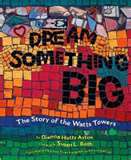 The Center for Cartoon Studies presents: Adventures in Cartooning (how to turn your doodles into comics!) by James Sturm, Andrew Arnold, and Alexis Frederick-Frost is just what the budding cartoonist needs. A knight, a magical elf, and a candy-loving horse are on a quest to defeat a dragon, but the plot is only a part of this book’s charm. With each step in the adventure, we learn a new technique in cartooning. The little boxes around the pictures are called panels, and changing the background in the panels can make it look like the characters inside the panels are traveling. “In comics,” explains the elf, “words are as important as pictures!” so when the knight wants to let the reader know the castle wall is a thousand miles long, he doesn’t have to draw a reaaallly big panel to contain it all, he describes with his words in a speech bubble. In the end when all seems lost, the characters take fate into their own hands, by drawing and writing a new ending that leads to the next great adventure.
The Center for Cartoon Studies presents: Adventures in Cartooning (how to turn your doodles into comics!) by James Sturm, Andrew Arnold, and Alexis Frederick-Frost is just what the budding cartoonist needs. A knight, a magical elf, and a candy-loving horse are on a quest to defeat a dragon, but the plot is only a part of this book’s charm. With each step in the adventure, we learn a new technique in cartooning. The little boxes around the pictures are called panels, and changing the background in the panels can make it look like the characters inside the panels are traveling. “In comics,” explains the elf, “words are as important as pictures!” so when the knight wants to let the reader know the castle wall is a thousand miles long, he doesn’t have to draw a reaaallly big panel to contain it all, he describes with his words in a speech bubble. In the end when all seems lost, the characters take fate into their own hands, by drawing and writing a new ending that leads to the next great adventure.
Students will love all the techniques they learn in Adventures in Cartooning. You can put those skills to use in a writing activity that shows reading comprehension. Give students a simple story, perhaps a folk tale, or a short story that fits in with some part of your curriculum. After your students read the story, or after you’ve read it to them, let them make a comic strip that will show part of the plot or information they learned. Encourage students to use word balloons and thought balloons (there’s a difference in how they are drawn so readers know if the words are spoken aloud or thought in a character’s head!), panels, lines for movement and action, and backgrounds. Model for students how you might draw a panel to show action. It’s not about perfect drawing, but in finding a way to express your ideas in pictures and in words. In this one lesson, you’ll enhance the Common Core State Standards of Print Concepts, Phonics and Word Recognition, Key Ideas and Details, and Craft and Structure. Even better, your students will be involved in meaningful reading and writing – and enjoying it!







